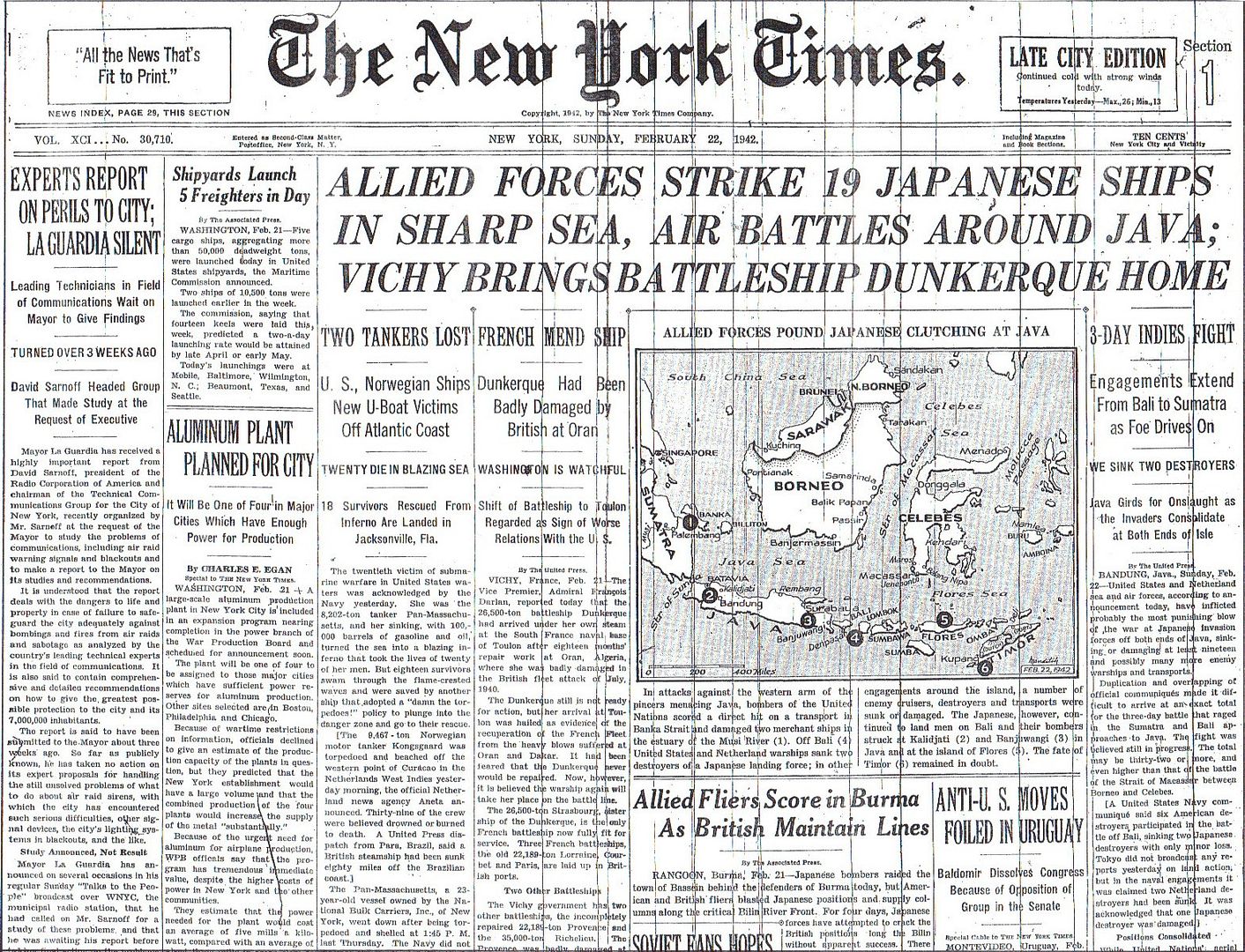
Posted on 02/22/2012 4:11:01 AM PST by Homer_J_Simpson

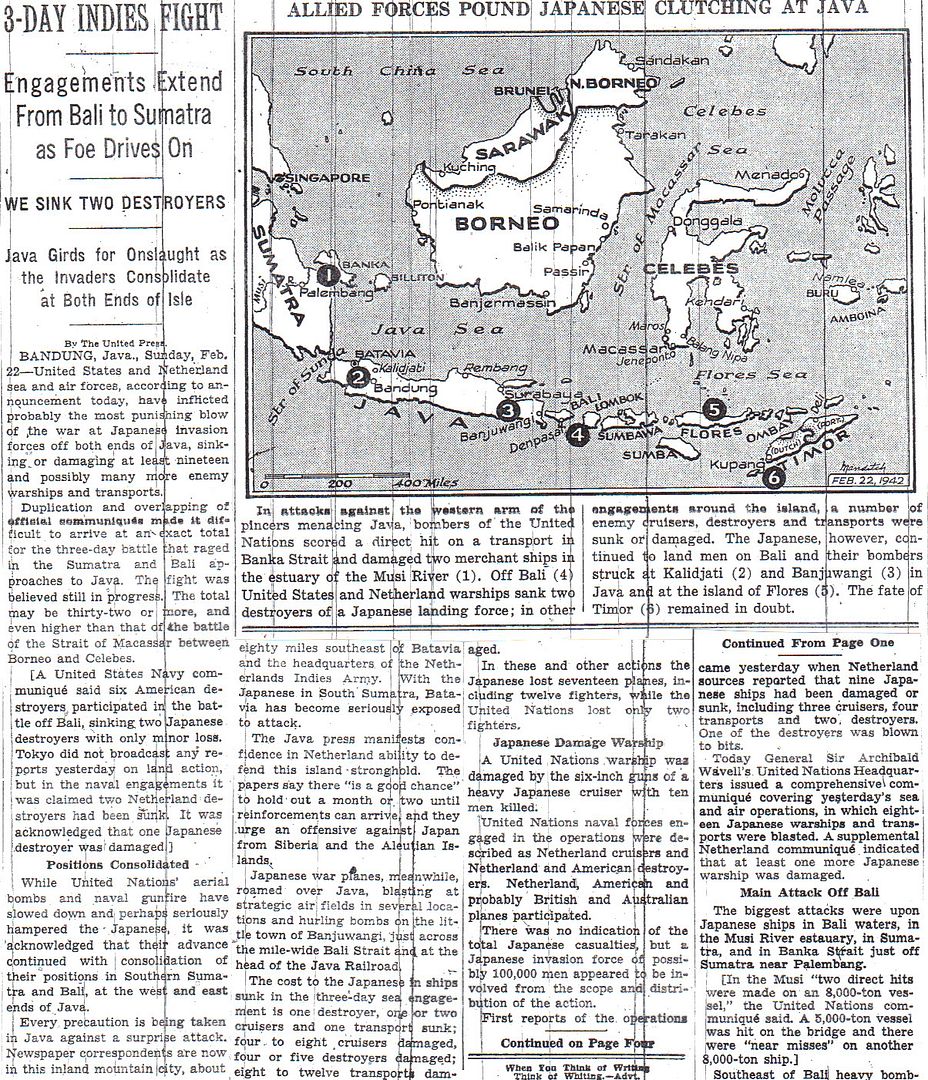
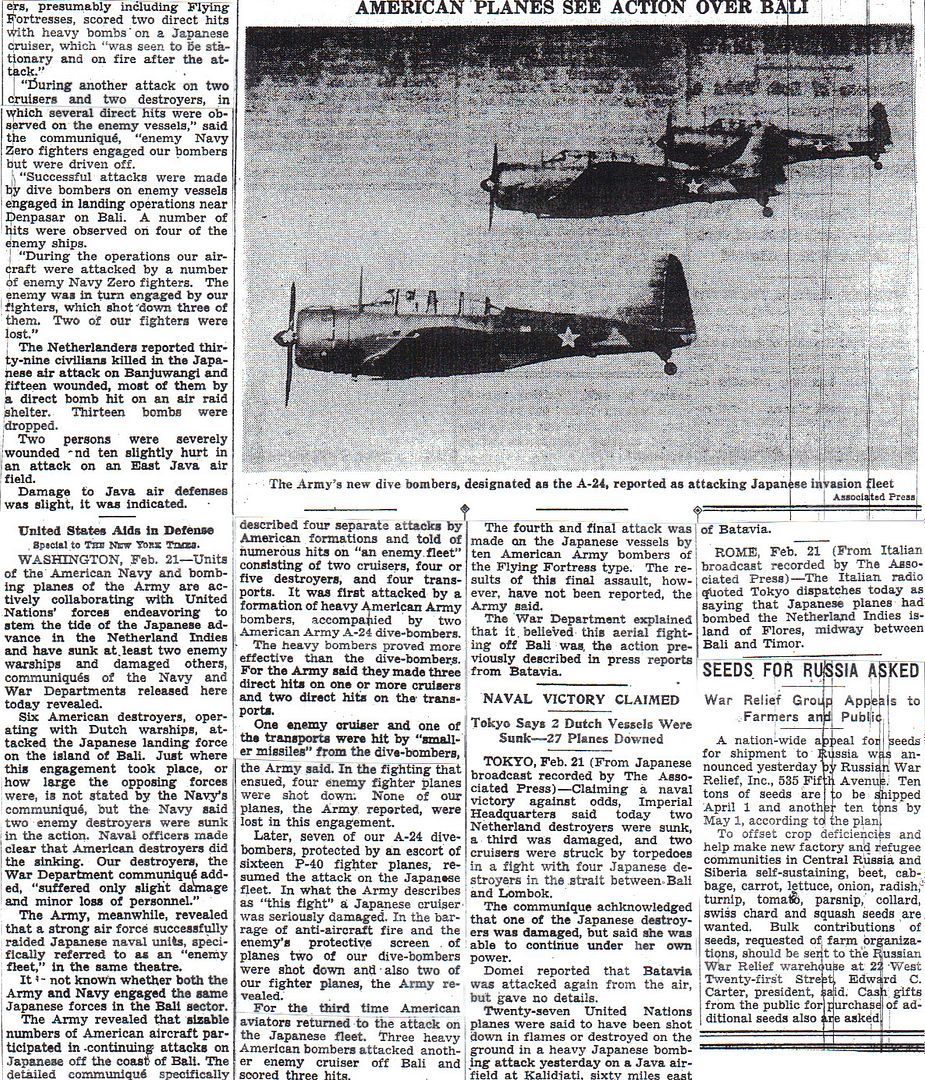
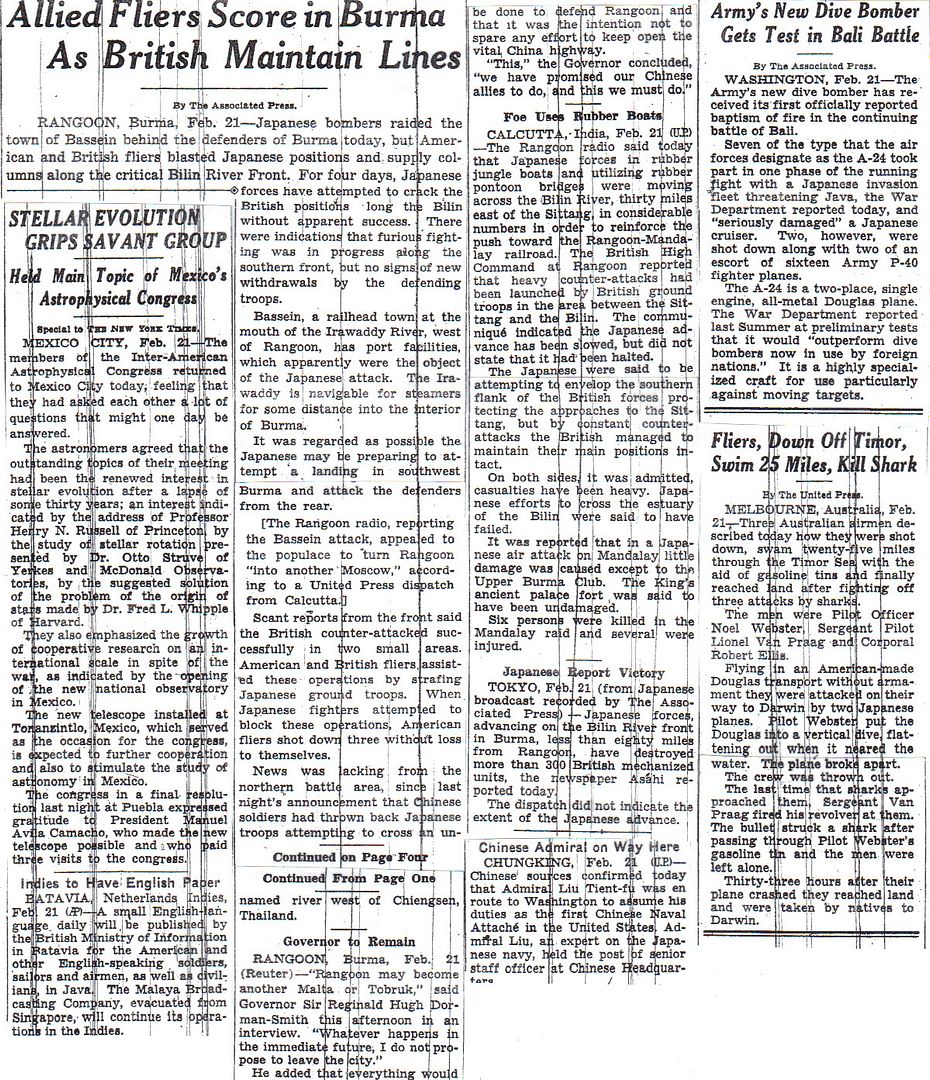
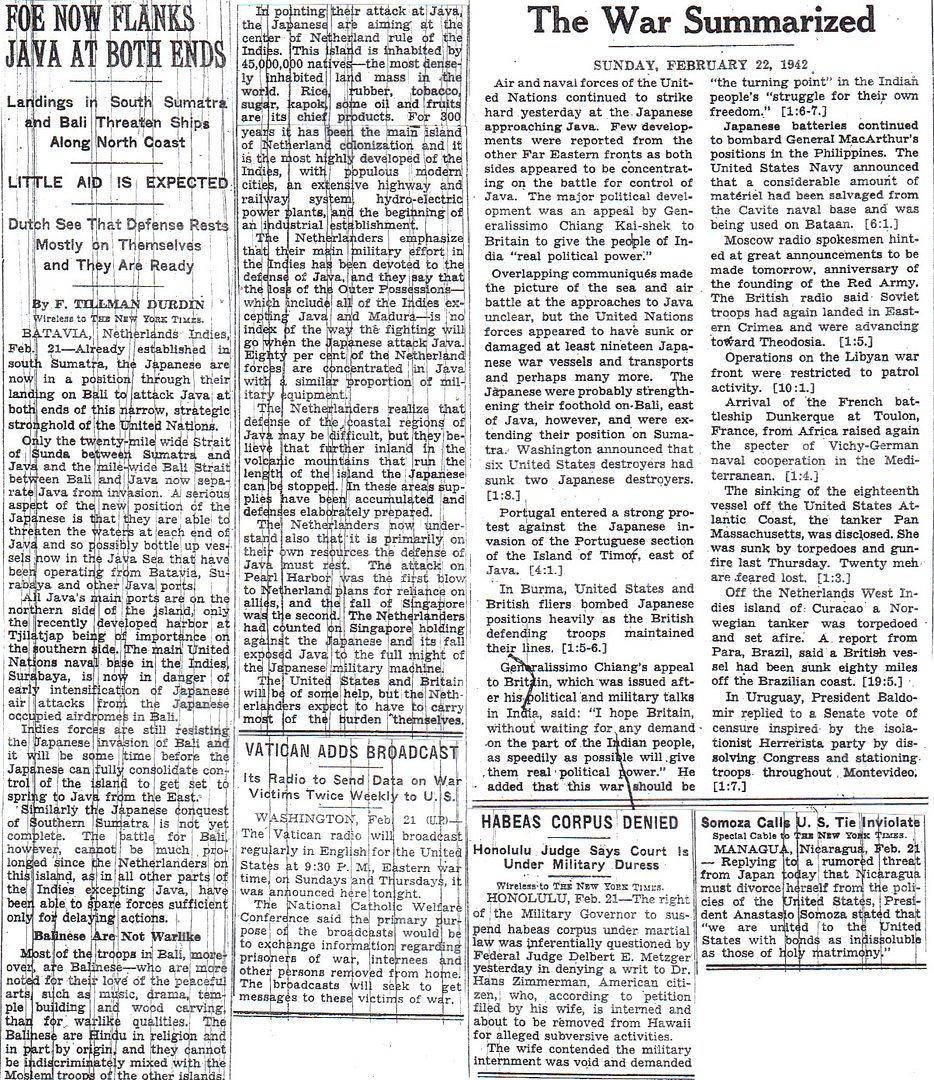
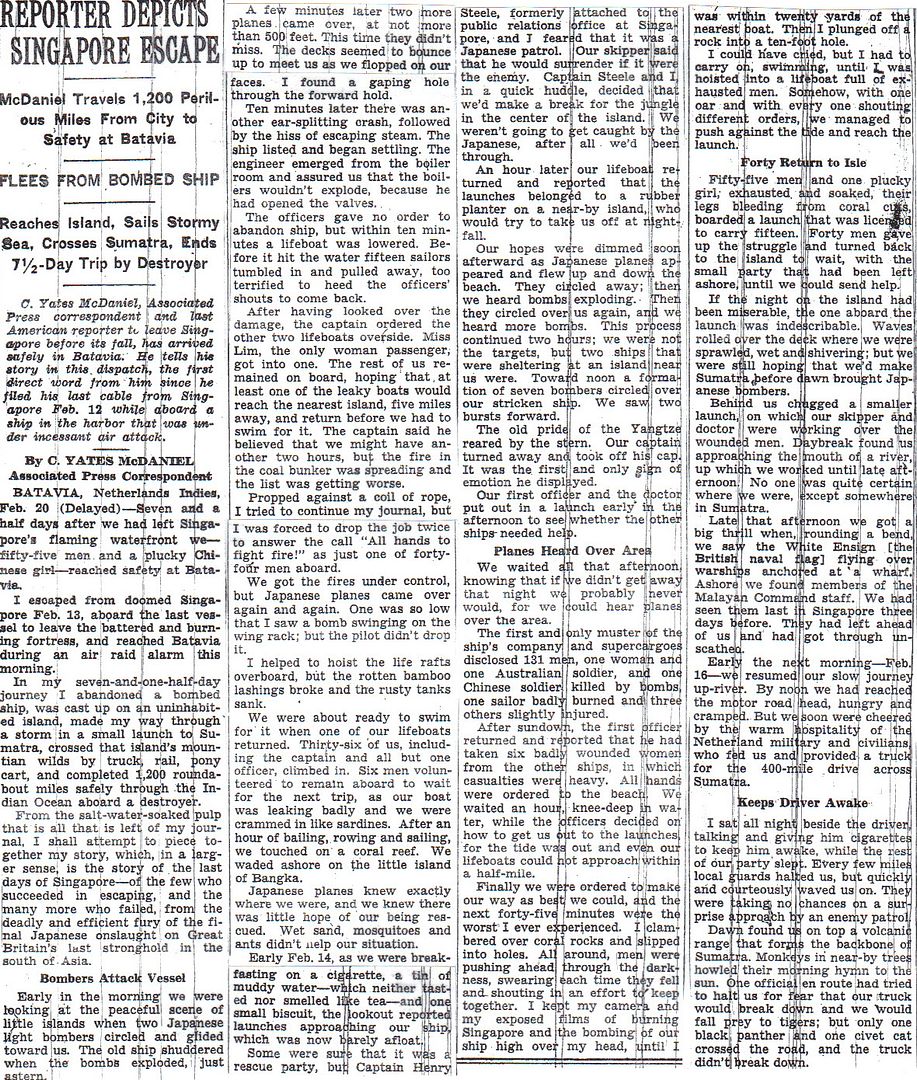
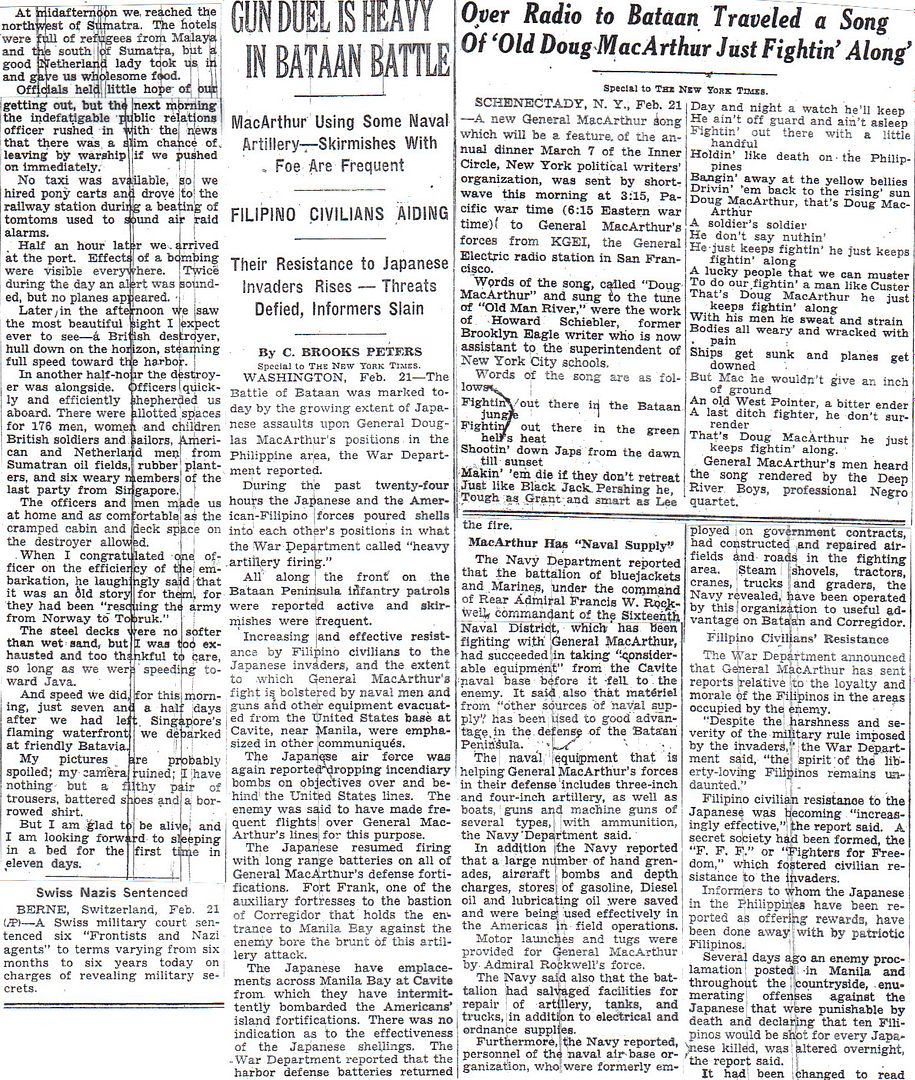

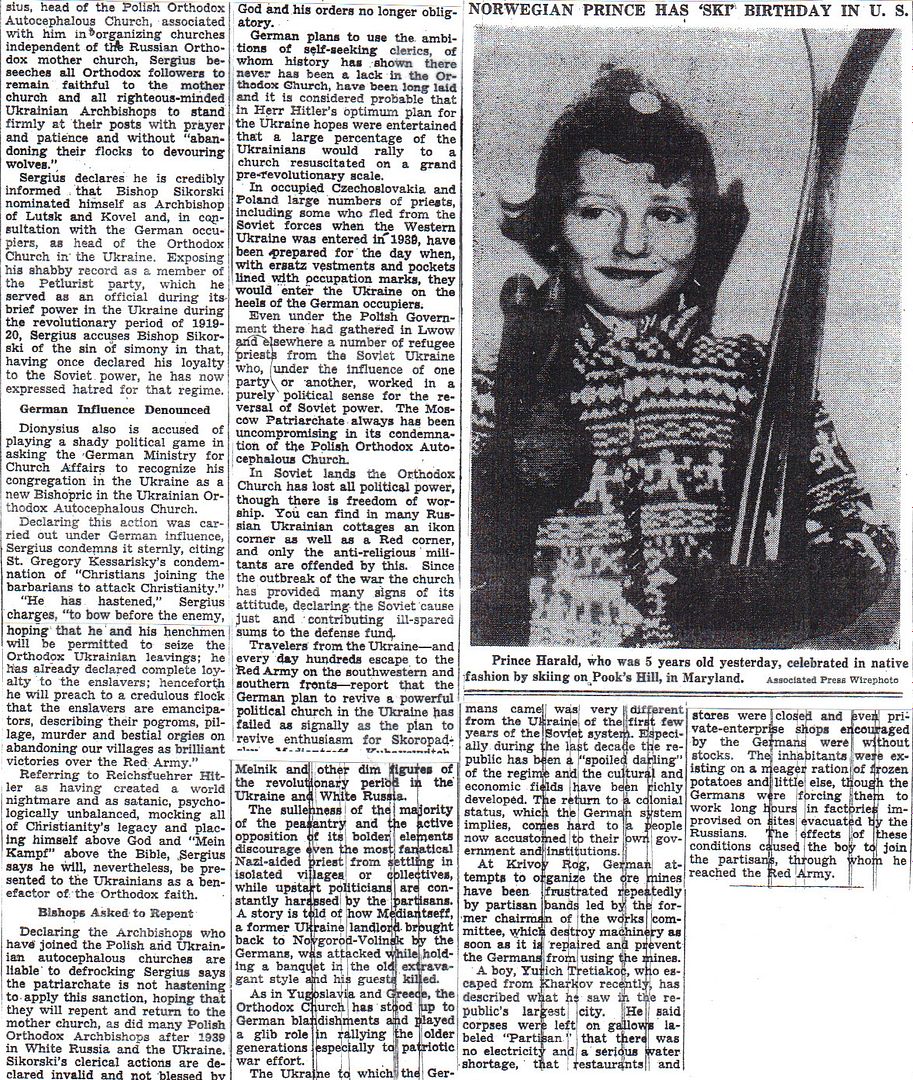
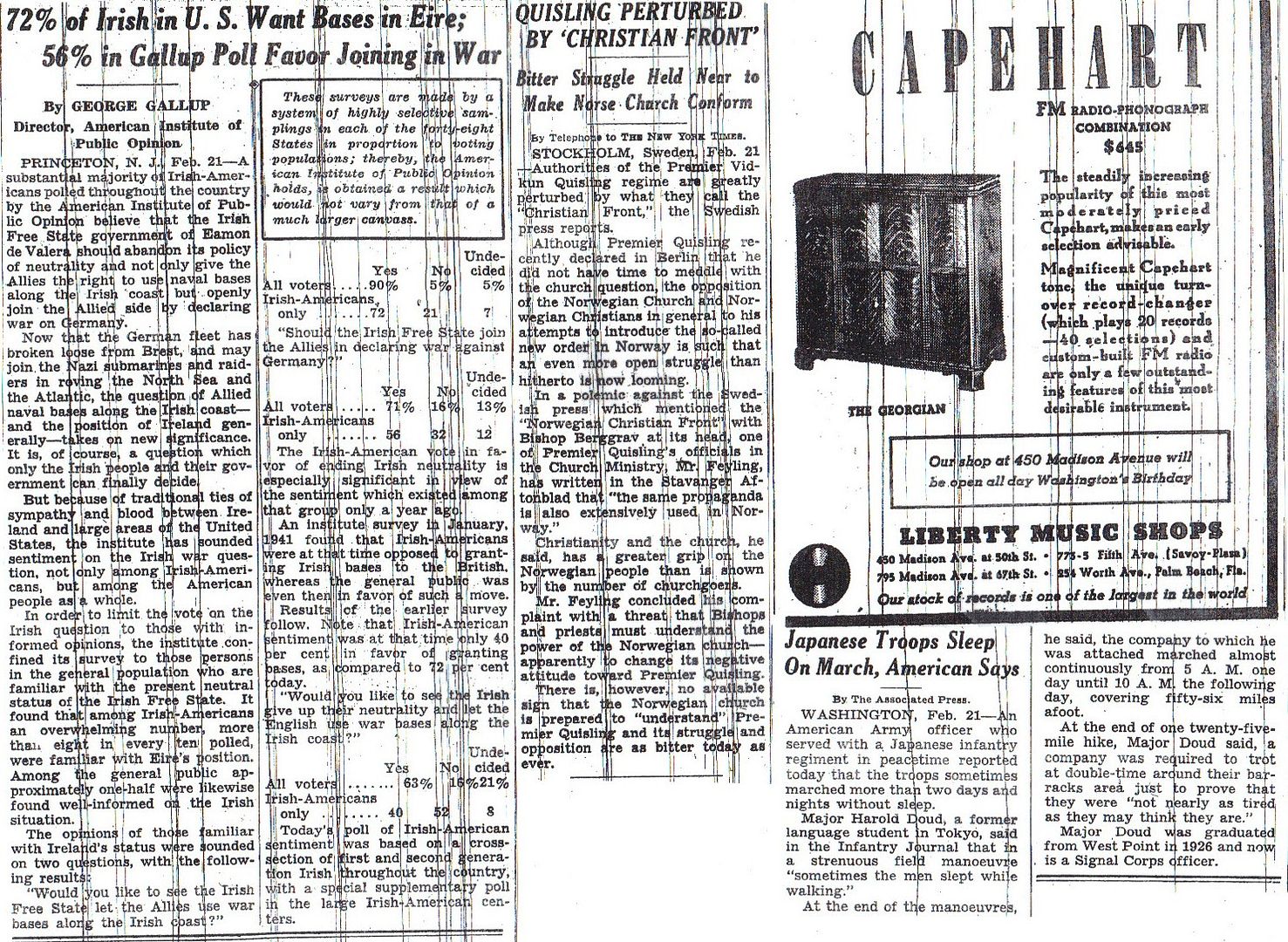
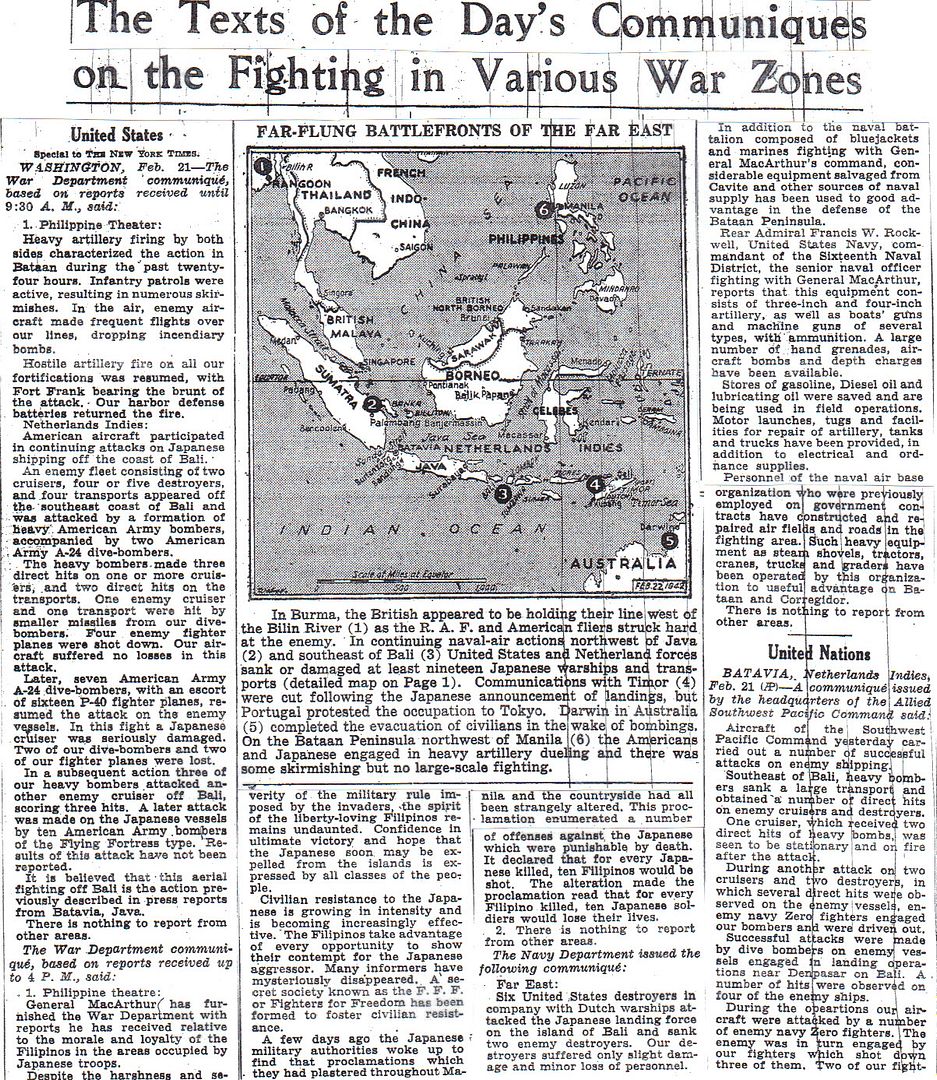
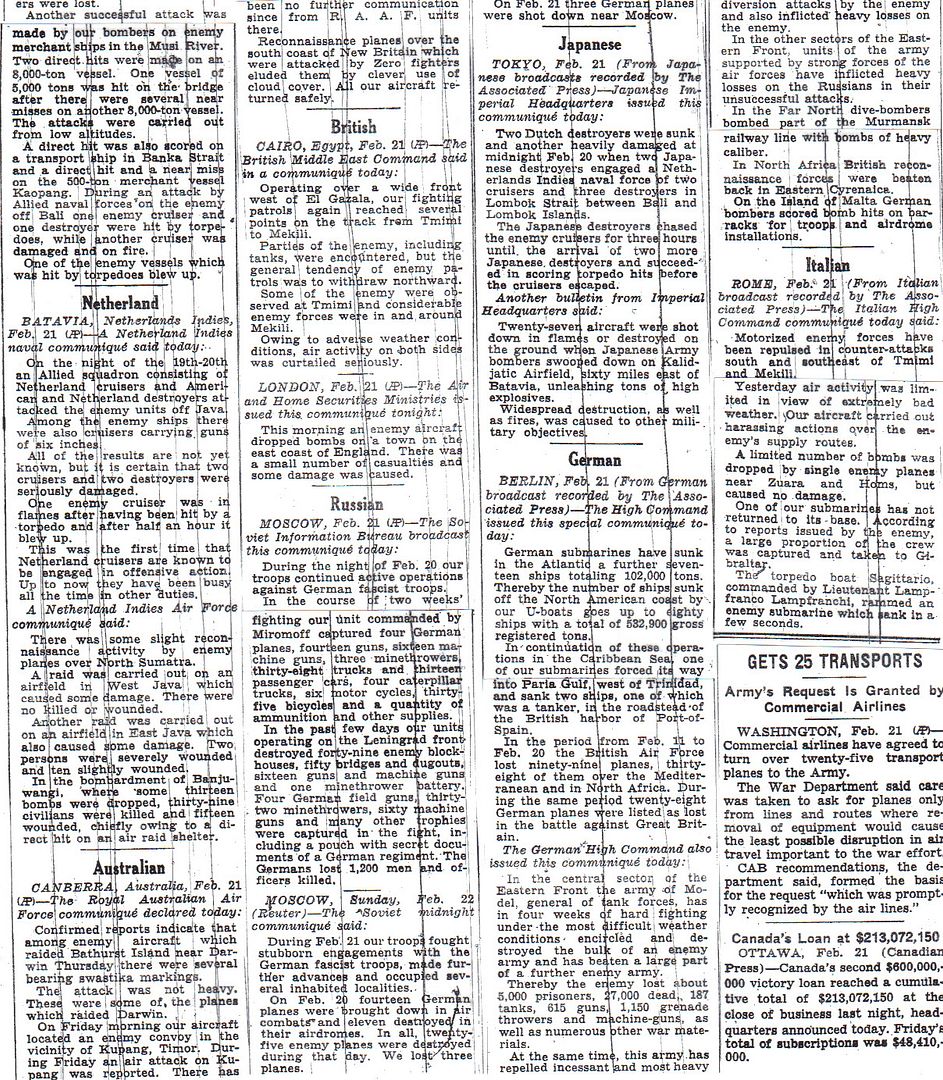
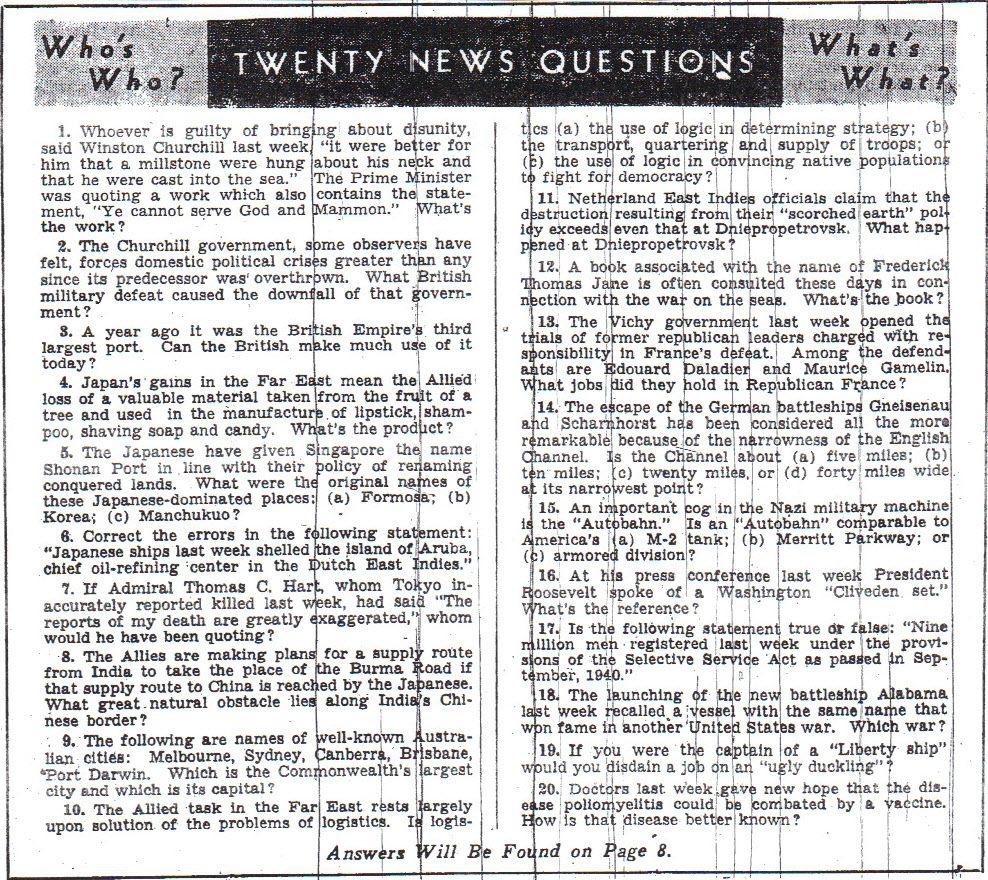
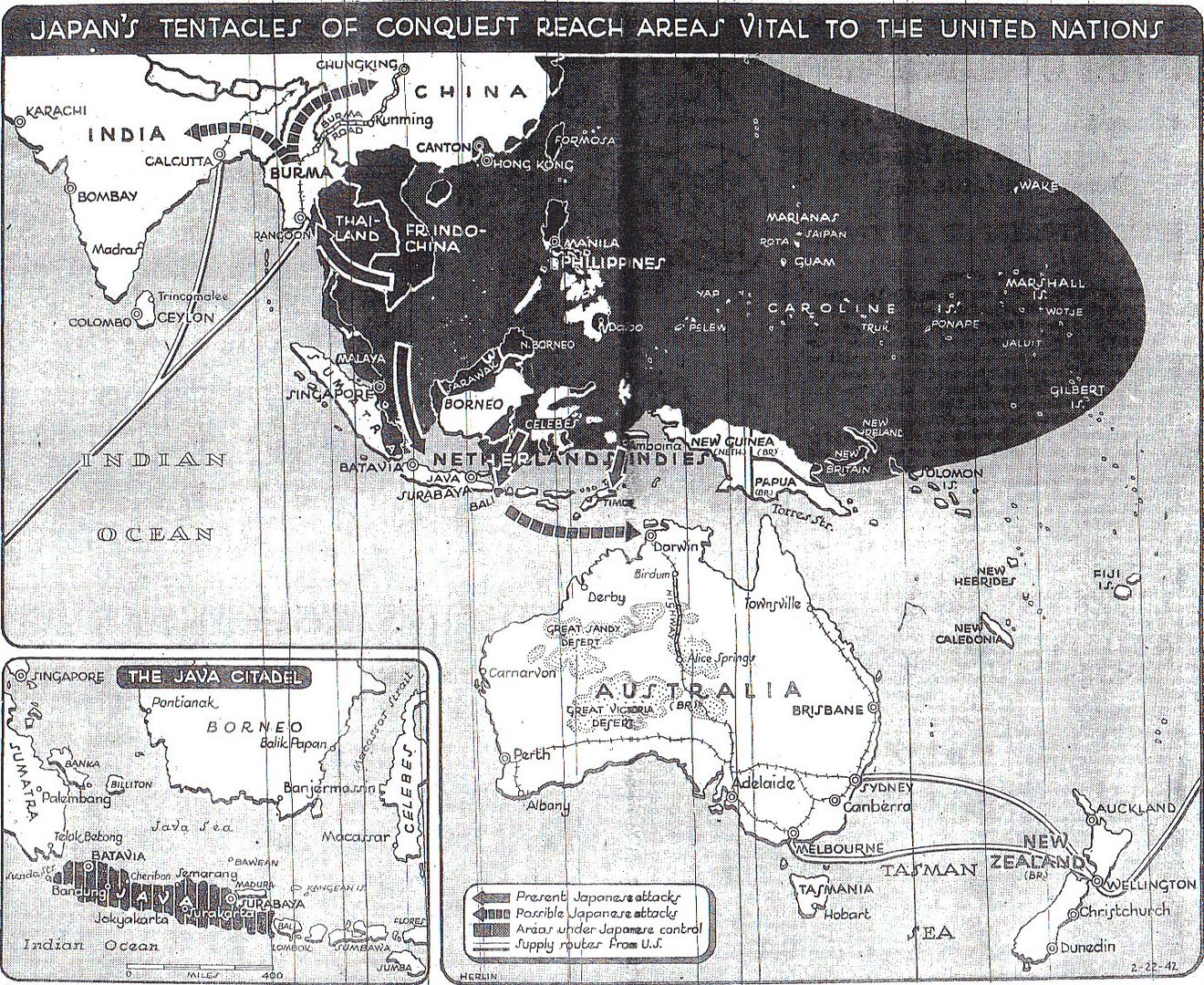

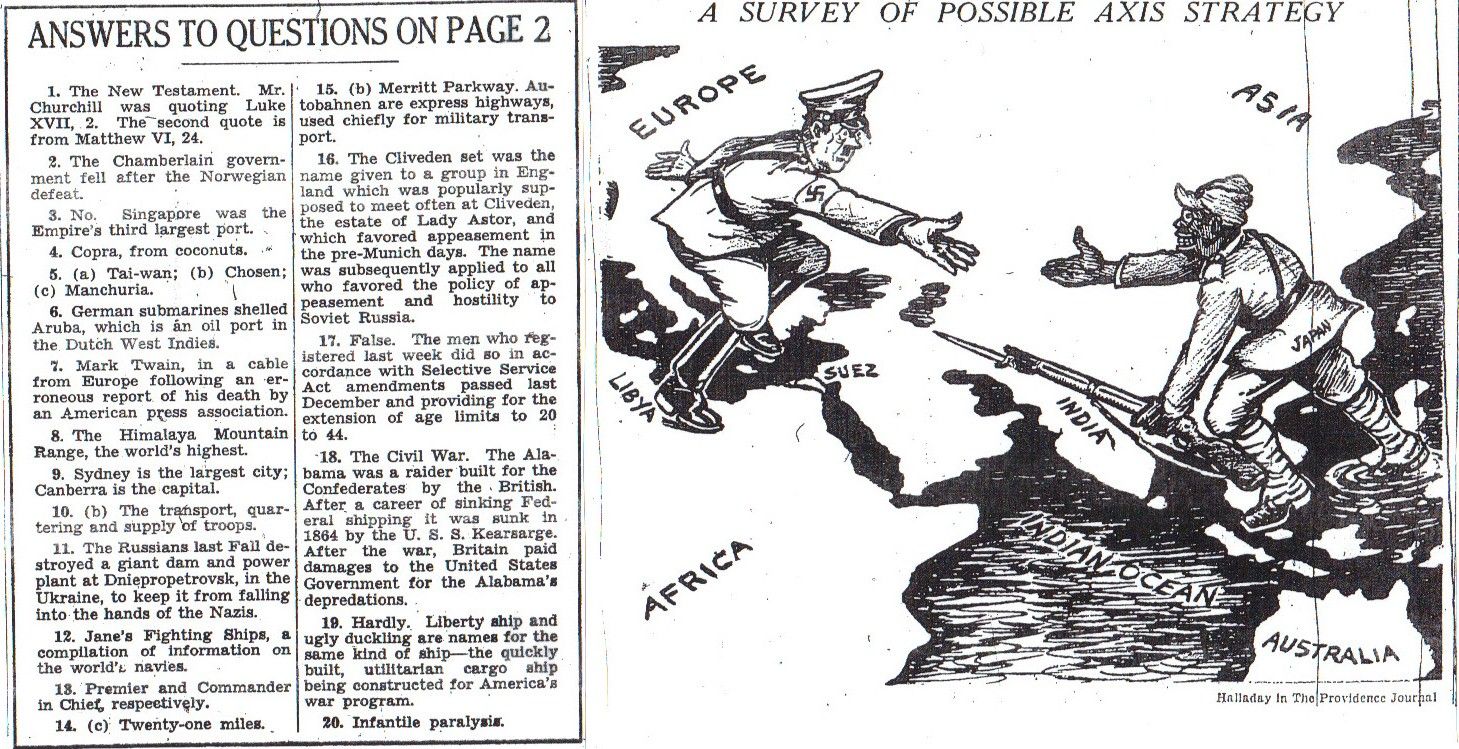
The News of the Week in Review
Twenty News Questions – 13
Japan’s Tentacles of Conquest Reach Areas Vital to the United Nations (map) – 14
Japanese Tide Flows to Three Big Fronts (by Hanson W. Baldwin) – 15
Answers to Twenty News Questions – 16
http://www.onwar.com/chrono/1942/feb42/f22feb42.htm
New spirit for Bomber Command
Sunday, February 22, 1942 www.onwar.com
Arthur HarrisFrom London... Air Marshal Harris, is appointed head of Bomber Command. He will be responsible for implementing the new policy of “civilian target” bombing from the Air Ministry.
From Washington... General Douglas MacArthur is ordered to leave the Philippines and establish new headquarters in Australia.
In Burma... Japanese troops continue their advances against the British 17th Indian Division at Mokpalin on the Sittang River. Fighting is extremely heavy.
http://homepage.ntlworld.com/andrew.etherington/month/thismonth/22.htm
February 22nd, 1942
UNITED KINGDOM: Air Marshall Arthur Harris, aged 49, is appointed Head of Bomber Command for the RAF.
He first went to war against the Germans with the 1st Rhodesian Regiment in South-west Africa in 1915. He has 20 years experience of bombing. He learnt the hard way - flying worn-out Bristol Fighters on punitive raids against the tribesmen of the North-West Frontier, and Vickers Vernon transports fitted with bomb racks against Iraqi rebels. He has since commanded No. 4 Bomber Group and, for a year of the war, No 5 Bomber Group.
Known to his friends as “Bert”, he is a prickly individual and no respecter of authority. It is possibly for this reason that he has caught the eye of Churchill. He believes in strategic bombing and can be relied on to carry out Bomber Command’s new orders to attack German civilian morale. He faces opposition, however, from those who regard his command as a costly diversion of resources.
The first USAAF HQ in Europe is formed when HQ of U.S. Army Bomber Command, U.S. Army Forces, British Isles (USAFBI), is established under Major General Ira C. Eaker.
London: Hugh Dalton is appointed president of the board of trade.
Destroyers HMS Partridge and Albrighton commissioned. (Dave Shirlaw)
BELGIUM: During the night of the 22-23d, three RAF Bomber Command aircraft bomb the port area of Ostend.
GERMANY: During the night of the 22-23d, 36 RAF Bomber Command aircraft attempt to bomb the floating dock at Wilhelmshaven which the Germans might be using to repair the battleships Scharnhorst or Gneisenau. The area was cloud-covered and bombs were mostly released on the estimated position of the city. Three other aircraft bomb the city of Emden.
BURMA: Civilians flee as British forces retreat to the Sittang River.
The Japanese open a strong attacks against two brigades of the Indian 17th Division east of the Sittang River in the Mokpalin area before a withdrawal through the Sittang bridge bottleneck can be accomplished. In a murderous, daylong fight, the Gurkhas hold the bridge, allowing other Allied units to escape to the river’s west bank. The Sitting River is the last barrier before Rangoon.
MALAYSIA: Parit Sulong: About 145 Australian troops, trapped by a Japanese roadblock trying to break through swamp and jungle to reach British lines. Before setting off, they leave their wounded at the roadside, “lying huddled around trees, smoking calmly, unafraid.” The Japanese capture the men and shoot them. More and more still.... (Mike Yared)
COMMONWEALTH OF THE PHILIPPINES: Submarine USS Swordfish (SS-193) disembarks Philippine President Manuel Quezon and his party at San Jose, Panay, to continue their journey out of the archipelago.
NETHERLANDS EAST INDIES: On Java, Japanese aircraft destroy five USAAF 5th Air Force bombers on the ground, four B-17 Flying Fortresses at Pasirian Airdrome and an LB-30 Liberator at Jogjakarta Airdrome.
On Bali, 5th Air Force bombers attack de Pasar Airdrome and destroy Japanese aircraft on the ground.
AUSTRALIA: Five Allied ships leave Fremantle, Western Australia, with 69 USAAF P-40s, motor vehicles and U.S. Army troops destined for Bombay, India. Two ships of the convoy are the seaplane tender USS Langley (AV-3, ex CV-1), carrying 32 assembled P-40s, and the merchant ship SS Sea Witch, carrying 27 crated fighters; these two ships are destined for Tjilatjap, Java.
Canberra: The Australian prime minister, John Curtin, blocks Churchill’s plan to send Australian troops to Burma.
U.S.A.: President Franklin D. Roosevelt orders General Douglas MacArthur, Commanding General U.S. Army Forces, Far East (USAFFE), to leave the Philippines.
CARIBBEAN SEA: At 0159, the unescorted and unarmed SS J.N. Pew was hit by one of two torpedoes fired by U-502 about 225 miles west of Aruba, while steaming completely blacked out on a zigzagging course at 11 knots. The torpedo struck on the port side between the main mast and the amidships pump room. The explosion sprayed oil over the entire length and set the amidships house afire. The burning tanker was sunk by four coup de grâce fired at 0235, 0242, 0254 and 0304. The eight officers and 28 crewmen tried to abandon ship in the rough seas, but two of the four lifeboats and two floats were destroyed by the fire. One lifeboat cleared the ship with only two men in it and reached shore about 35 miles east of Riohacha, Colombia on 25 February. Friendly Indians helped them reach Riohacha, from where they were taken to Barranquilla, Colombia. A second boat swamped when it hit the water and ten survivors managed to right the boat the next morning, but had to set sail without water, food and survival equipment. On 14 March, only one man was alive when the boat was found by a patrol aircraft off Cristobal, which directed the Panamanian motor merchant Annetta I to it. He was taken to the Coco Naval Base, where he was hospitalized for several weeks before he was able to be sent home. None of the officers survived the sinking. (Dave Shirlaw)
ATLANTIC OCEAN: At 1151, the unescorted US tanker SS Cities Service Empire was hit by two torpedoes from U-128 about 25 miles north of Bethel Shoals off the Florida coast. The tanker had maintained a non-evasive course at 10 knots in moderate to heavy seas and had been missed by the first four torpedoes. The torpedoes struck the vessel amidships at the after pump room deep in the ship’s bowels on the starboard side. Fire broke out immediately and within seconds the ship and the water around the tanker were ablaze. The armed guards (the ship was armed with one 5in, two .50cal and two .30cal guns) were driven away from their guns and the master gave the order to abandon ship after 10 minutes. All lifeboats had been destroyed by the fire and only two rafts could be launched. Most of the crew of eight officers, 33 men and nine armed guards jumped overboard. USCGC Vigilant reached the burning ship and the commanding officer saw three men at the bow of the tanker. Nosing his ship up to the burning tanker, some men crawled aboard the ship and battled the flames until they rescued two of them. But before they could go back for the third, the tanker exploded, showered the cutter with unignited oil from stem to stern, broke in two and sank at 1210 hours. The master, three armed guards and ten crewmen died. The 34 survivors on the rafts were later picked up by USS Biddle and taken to Fort Pierce, Florida. (Dave Shirlaw)
At 0455, the unescorted and unarmed Republic was hit by two torpedoes from U-504 about 3.5 miles northeast of Jupiter Island Lighthouse, Florida. The torpedoes hit on the port side 35 to 50 feet from the stern. The explosions destroyed the engine room, killed one officer and two crewmen on watch below and sprayed oil from the bunkers over the entire ship. As the tanker developed a starboard list and settled by the stern the survivors among the seven officers and 22 crewmen on board abandoned ship in two lifeboats. Two crewmen drowned. One boat with the master and 21 survivors rowed to shore, where they were taken care by residents before they were taken to Palm Beach by trucks. Seven others in the second boat were picked up by the Cities Service Missouri and taken to Port Everglades. The badly damaged Republic was located the next day by the USCG, but she drifted on to reefs about five miles due east of Hobe Sound, Florida and sank on the afternoon of 23 February. (Dave Shirlaw)
An unarmed U.S. freighter, the SS West Zeda, is torpedoed and sunk by German submarine U-129 about 125 miles (201 kilometres) southeast of Trinidad, British West Indies at 09.13N, 59.04W.
At 0703, U-155 fired torpedoes at Convoy ONS-67 south of Cape Farewell and heard three detonations. CO Piening observed no effects after the first detonation, but saw explosions on two other ships. He claimed two ships with 15.000 tons sunk and another with 7000 tons damaged but in fact only the Adellen and Sama were hit and sunk. 29 crewmembers and seven gunners from the Adellen were lost. The master, nine crewmembers and two gunners were picked up by HMCS Algoma, transferred to British rescue ship Toward and landed at Halifax on 1 March. Sama was hit by a torpedo at 0703 in the stern and sank in 3-4 minutes in complete darkness. 20 survivors were picked up from debris by destroyer USS Nicholson and rescue ship Toward after two hours.
At 2257, the Kars was torpedoed by U-96 south of Halifax. The tanker had been in Convoy ONS-67, but lost the convoy and turned back. The ship caught fire and broke in two three days later. The forepart sank and the after part was towed to Halifax, where it was beached on 27 February and declared at total loss. The master, 45 crewmembers and four gunners were lost. Two crewmembers were picked up by minesweeper HMCS Melville and landed at Halifax.
The Torungen was lost with all hands. The crew consisted of 12 Norwegians, three Danes, one Swede, one Fin, one Dutchman and one Estonian. A 2/3 water-filled lifeboat with the body of the second engineer was later found off Lockport , Nova Scotia.
SS George L Torian (1,754 GRT) Canadian Upper Lakes Company bulk carrier was sunk in the Caribbean off British Guyana, in position 09.13N, 059.04W, by U-129, Kptlt Nicolai Clausen, Knight’s Cross, CO. Torian was on route from Paramaribo, Dutch Guiana, to Trinidad with a load of bauxite for transhipment. A boat with fifteen of her crewmembers was questioned by the U-boat CO and then was provided with food, water, and directions to the nearest land. A USN PBY Catalina patrol aircraft rescued four other survivors. (Dave Shirlaw)
http://en.wikipedia.org/wiki/Battle_of_Badung_Strait
The Battle of Badung Strait was a naval battle of the Pacific campaign of World War II, fought on the night of 19/20 February 1942 in Badung Strait (not to be confused with the port of Bandung) between the American-British-Dutch-Australian Command (ABDA) and the Imperial Japanese Navy. In the engagement, the four Japanese destroyers defeated an Allied force that outnumbered and outgunned them, escorting two transports to safety and sinking the Dutch destroyer Piet Hein. The battle demonstrated the Japanese Navy’s considerable superiority over the Allies in night fighting which lasted until the Battle of Cape St. George.
http://www.smmlonline.com/articles/badoeng.html
The fall of Bali and the naval battle of the Badoeng Strait 18 - 20 of February of 1942
http://www.netherlandsnavy.nl/battle_balitimor.html
Fire in the Night: The loss of Bali and Timor

McDaniel’s recount of his escape from Singapore sounds a lot like the Alistair MacLean novel “South by Java Head” which I read in junior high school. In fact, I wouldn’t be surprised if McDaniel was in fact the inspiration for the book.
http://www.goodreads.com/book/show/149623.South_by_Java_Head
South by Java Head
by Alistair MacLean
February, 1942: Singapore lies burning and shattered, defenceless before the conquering hordes of the Japanese Army, as the last boat slips out of the harbour into the South China Sea. On board are a desperate group of people, each with a secret to guard, each willing to kill to keep that secret safe. Who or what is the dissolute Englishman, Farnholme? The elegant Dutch planter, Van Effen? The strangely beautiful Eurasian girl, Gudrun? The slave trader, Siran? The smiling and silent Nicholson who is never without his gun? Only one thing is certain: the rotting tramp steamer is a floating death trap, carrying a cargo of human TNT.Dawn sees them far out to sea but with the first murderous dive bombers already aimed at their ship. Thus begins an ordeal few are to survive, a nightmare succession of disasters wrought by the hell-bent Japanese, the unrelenting tropical sun and by the survivors themselves, whose hatred and bitterness divides them one against the other.Written after the acclaimed and phenomenally successful HMS Ulysses and The Guns of Navarone, this was MacLean-s third book, and it contains all the hallmarks of those other two classics. Rich with stunning visual imagery, muscular narrative power, brutality, courage and breathtaking excitement, the celebration of the 50th anniversary of South by Java Head offers readers a long-denied chance to enjoy one of the greatest war novels ever written.
See what I mean?
Disclaimer: Opinions posted on Free Republic are those of the individual posters and do not necessarily represent the opinion of Free Republic or its management. All materials posted herein are protected by copyright law and the exemption for fair use of copyrighted works.